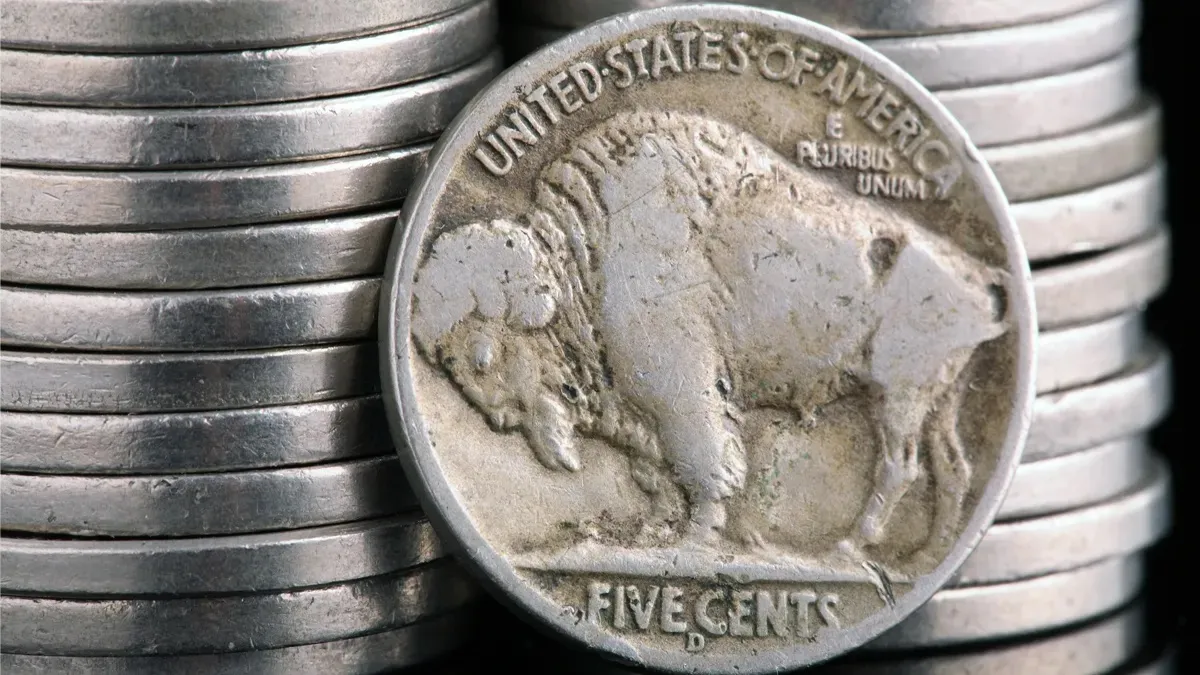Nickels, the versatile five-cent coins that have been in circulation for over a century, hold an intriguing position in the realm of currency. Often overlooked due to their modest denomination, nickels possess a unique worth that extends beyond their face value. In this article, we will delve into the composition, history, and intrinsic value of nickels, shedding light on their significance in the numismatic world.
Composition And Design
Nickels in the United States are composed of a cupronickel alloy, consisting of 75% copper and 25% nickel. This blend of metals provides durability and resistance to corrosion, ensuring their longevity in circulation. The coin’s diameter measures 21.21 mm and weighs 5 grams, making it larger and heavier than a penny or dime.
The obverse (front) side of the nickel features a portrait of President Thomas Jefferson, the nation’s third president, facing right. This iconic design, created by Felix Schlag in 1938, has remained relatively unchanged, with minor modifications over the years. On the reverse (back) side, the Monticello building, Jefferson’s historic residence, is showcased. This distinctive imagery pays homage to Jefferson’s contributions to American history and architecture.
Face Value
The face value of a nickel is five cents, as indicated by the inscription on the coin. However, it is crucial to understand that the face value does not necessarily reflect the coin’s overall worth. As inflation and economic factors evolve, the purchasing power of five cents may fluctuate. Nevertheless, the face value remains the baseline for transactions involving nickels in everyday commerce.
Numismatic Value
Beyond its face value, a nickel can possess additional worth as a numismatic collectible. Numismatics is the study and collection of coins, paper money, and related objects. Several factors contribute to the numismatic value of a nickel, such as its rarity, historical significance, condition, and demand among collectors.
Rare and error coins can fetch substantial prices among numismatists. For instance, the 1913 Liberty Head nickel, of which only five specimens are known to exist, sold for millions of dollars at auction. Similarly, certain coins with minting errors, such as double die varieties or off-center strikes, can command higher values due to their scarcity and appeal to collectors.
Condition is another essential aspect affecting the numismatic value of nickels. Coins in pristine condition, with minimal wear and original luster, generally command higher prices than those showing signs of extensive use or damage.
Market Value
The market value of nickels, particularly those not considered rare or error coins, is primarily influenced by the prevailing price of copper and nickel in the metals market. As the cost of these metals fluctuates, it can affect the intrinsic value of the cupronickel alloy used in the coin’s composition. However, for common-date nickels without numismatic significance, their intrinsic value typically remains below or near their face value.
Historical Significance
Nickels have played a vital role in American currency since their introduction in 1866. The decision to mint a new five-cent coin was prompted by the need for a coin that was easier to handle and distinguish from other denominations. Prior to the nickel, the five-cent denomination was represented by the half-dime, which was smaller and made of silver.
The Shield nickel, introduced in 1866, was the first five-cent coin to be produced in nickel alloy. It featured a shield design on the obverse and an intricate wreath on the reverse. Over the years, the design of nickels has evolved, with various iterations reflecting the changing artistic tastes and historical events of the nation.
Notable Editions
1- Buffalo Nickel (1913-1938):
The Buffalo nickel, also known as the Indian Head nickel, is one of the most beloved and iconic coin designs in American history. Designed by James Earle Fraser, it featured a Native American chief on the obverse and an American bison on the reverse. The Buffalo nickel remains highly sought after by collectors due to its unique design and historical significance.
2- Jefferson Nickel (1938-present):
The Jefferson nickel, introduced to commemorate the 200th anniversary of Thomas Jefferson’s birth, replaced the Buffalo nickel. It features Thomas Jefferson’s portrait on the obverse and his residence, Monticello, on the reverse. Throughout its history, the Jefferson nickel has undergone minor design changes, including variations in Jefferson’s profile and the addition of the Monticello image.
3- War Nickels (1942-1945):
During World War II, nickel was in high demand for military use. To conserve the metal, the composition of the nickel was altered. War nickels were made from a 35% silver alloy instead of the traditional cupronickel blend. These coins can be identified by the large mint mark above the Monticello image on the reverse.
4- Westward Journey Nickel Series (2004-2006):
In celebration of the Lewis and Clark expedition’s bicentennial, the U.S. Mint released a series of nickels that featured various designs depicting the journey and its significance. This series included images of President Jefferson, Lewis and Clark’s keelboat, and scenes of Native American and American West culture.
Everyday Transactions
Nickels, along with other coins, play a crucial role in facilitating everyday transactions. While the value of a single nickel may seem minimal, these coins add up and can make a significant difference, particularly in smaller purchases. They are commonly used for vending machines, parking meters, public transportation fares, and various other transactions where exact change is required.
Accumulating nickels can also be a part of saving strategies. Some people choose to save their loose change, including nickels, in coin jars or piggy banks. Over time, these collections can accumulate into substantial sums, which can be used for specific purposes or converted into other forms of currency.
Intrinsic And Face Value
The intrinsic value of a nickel refers to the worth of the metal it contains. As mentioned earlier, the cupronickel alloy used in nickels is a combination of copper and nickel. The value of these metals fluctuates in the commodities market based on supply and demand. While the metal content of nickel may have some value, it is often lower than the coin’s face value due to manufacturing costs, distribution expenses, and the coin’s status as legal tender.
It is worth noting that the United States Treasury, the entity responsible for minting and issuing currency, does not adjust the composition of nickels or other coins based on fluctuations in metal prices. Instead, they aim to strike a balance between practicality, durability, and cost efficiency when producing coins.
Conclusion
Nickels may seem unassuming in terms of their face value, but their historical significance and numismatic worth make them fascinating to collectors and enthusiasts alike. From the early Shield nickel to the iconic Buffalo nickel and the enduring Jefferson nickel, these coins hold stories of America’s past and the artistry that shaped its currency. Whether you encounter a rare edition or simply appreciate the everyday circulation of nickels, their value extends beyond their monetary denomination, making them an integral part of the numismatic landscape.
ALSO READ / how to choose the right facial



